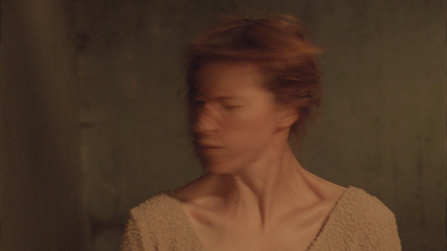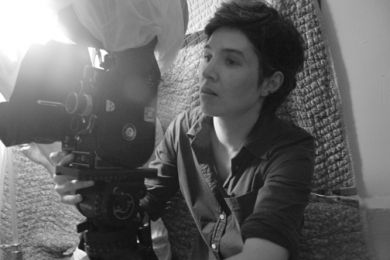On Tuesday, we broke the story of how Asheville-native filmmaker Melika Bass was commissioned by Icelandic band Sigur Rós to create a video for the group’s new album, Valtari.
Bass was one of a dozen filmmakers given a small budget (and complete artistic freedom) to create short films inspired by one of the album’s tracks. (The project is called the Valtari Mystery Film Experiment, and films continue to be released: Aug. 27, Sept. 10 and 24, Oct. 8 and 22, Nov. 5 and 19. Bass’ was released on Monday, Aug. 13.) Bass worked with the song, “Varðeldur,” and with the choreographer/movement artist Selma Banich.
Bass spoke to Xpress from her home in Chicago about the process of making the short film.

Mountain Xpress: How did you come to be involved with the Valtari Mystery Film Experiment?
Melika Bass: A former colleague has been working with the band for the last couple of years. He knew they were putting the project together and assembling the filmmakers, and he thought they might like my work. He introduced them to it and they did [like it].
MX: How long did it take you to complete the film?
MB: The whole process was pretty short. I got the invitation in April and it was completed at the end of June. That was the deadline. And the performer I was working with lives in Zagreb, Croatia. We were doing this pretty fascinating thing back and forth over Skype. Rehearsing and talking. Then she came to Chicago and we kept rehearsing. We assembled the sequence in a week and shot it in a week. Then she was gone and I edited it for another week or two.
MX: How did you meet Selma Banich (the performer)?
MB: I worked with her on one of my films that showed at the Fine Arts Theatre [in Asheville] last year, called Waking Things. She’s a pretty established performer, dancer and choreographer in Zagreb, but she’s also part of this performance ensemble called Every House Has a Door. They two people who started it are based in Chicago, but every project is different for them, and they invite different international artists. Selma was part of a live performance with them, and they approached me to make a film with their performers. I had worked with [Selma] in the filmmaking thing a couple of years ago and we just loved working together, so when I found out about the Sigur Rós film… She’s someone who has a lot of depth in the way she moves and we communicate well. She’s someone who’s open to working with an unusual process. I also knew that she was sensitive enough that once she got into this pretty bizarre, grotesque space that we shot in, she’d really respond to it. This haunted basement.
MX: It the setting actually a basement?
MB: It is. It’s the basement of this huge building that’s now an apartment building in Chicago. It runs a whole city block and the basement is this series of rooms, and the ceiling is really low. There’s this weird T-shaped swimming pool. The lore in the neighborhood is that it was part of an illegal gangster casino. In Chicago, everyone wants to be a part of the Al Capone legacy, so when you hear that you go, “yeah, right.” But then I kept hearing stories about it, and the more I looked at the space it made sense. The lore is also that it was one of the first indoor swimming pools in the United States. It has all these beautiful rust stains from water damage, which we tried to preserve in the shooting. We had to wear face masks a lot because there was no ventilation. It looked very lived in and I wanted a space that was both visually evocative and a real space.
MX: Did all of the filmmakers choose their own songs, or were you assigned a song?
MB: The whole design of it is that they basically picked a dozen filmmakers whose work they really liked and said, “we’ll give you a small budget to do whatever you want and we don’t want to know what it is until you deliver the final file.” Complete artistic freedom was amazing, which is sort of why I agreed to do it. When I was first talking to their manager, he sent me the whole album and said, “Let me know what you respond to.” We went back and forth a couple of times, but this song [“Varðeldur”] was on my list.
I don’t think everyone got their first choice. Then again, the music is so evocative in general. It’s all kind of amazing. This song suits me in a way because it’s so meditative and has a haunted quality to it. I tend to start with spaces that have the appearance of a history to them. I’m interested in this fantasy of what could have happened here just by visually looking at it, and this is one of the creepiest places. It was really kind of scary!
And then I like working with performers who have these natural qualities, which I find very evocative. Selma’s highly trained, but she also just has a really expressive face and this fierce beauty. I knew I wanted to do something that had an emotional fluidity, and I knew that she would have the range to go back and forth between different states. I frequently work with non-actors because I want to capture a natural energy, but with Selma, this was about a physical entity and their movement and energy in a space that also has a weird energy to it. Doing that in six minutes, you know?
MX: The way Selma moves on the film is very eerie.
MB: We built this collection of images and ideas, going back and forth over Skype and in person. We sequenced them some, but then I wanted to have the freedom in editing to really fragment it more.
MX: As you were filming, did you have the piece of music playing?
MB: No, that was actually something that I realized right away — that I wanted to create a certain amount of space to generate an emotion and atmosphere that wasn’t illustrating what was in the song directly. I wanted to create something that could be layered with what’s in the song to create this other feeling.
I sent Selma the song, but then a couple of weeks later I actually asked her to stop listening to it. I didn’t want us to feel like we had to create something that directly corresponded to it. What we ended up doing, because I realized it still needed to be rooted in the song, was that we created these metronome tracks. She’s dancing to the rhythm. Some of the rhythms are from the song and some are modified from the song’s rhythm. I always knew I’d have the beats, in some way, or the off-rhythm to create some slippage. We had both definitely ingested the feeling of the song, so we didn’t need it there all the time. It’s really very ethereal and enveloping, so I wanted to give us some room to create our piece.
When we were shooting, I was listening to it, but no one else was. The crew didn’t know what song we were working on the entire time. I wanted the decisions to be separate. I think it actually helped. I didn’t want to make something with the exact same tone, because I think [Sigur Rós’] music is so powerful on its own. I wanted the visuals to work both with it and a little bit against it.
MX: Have you had any feedback from the band at this point?
MB: I’ve had a little bit through their manager and it seems like they like it. They’re touring right now, so they’re in that zone. But it’s been really cool to watch the other films as they come out. Everything is very different, but there’s this attention to intimacy or gesture that tends to be coming out.
MX: Is Chicago where you’re based these days?
MB: I’ve been here for 10 years now. I grew up in Asheville and went to junior high and high school there. My parents are still there. I go back a lot. I’m trying to get together a longer future project that I want to shoot [in Asheville] in the next couple of years. I did a lot of theatre when I was in high school — I was part of Asheville Contemporary Dance Theatre. I used to be a dancer; this was my first dance film in a long time.
Watch the film here:
Sigur Rós – Varðeldur from Sigur Rós Valtari Mystery Films on Vimeo.
Melika Bass photo courtesy of Mislav ÄŒavajda, from the Museum of Contemporary Art Chicago website.




Before you comment
The comments section is here to provide a platform for civil dialogue on the issues we face together as a local community. Xpress is committed to offering this platform for all voices, but when the tone of the discussion gets nasty or strays off topic, we believe many people choose not to participate. Xpress editors are determined to moderate comments to ensure a constructive interchange is maintained. All comments judged not to be in keeping with the spirit of civil discourse will be removed and repeat violators will be banned. See here for our terms of service. Thank you for being part of this effort to promote respectful discussion.